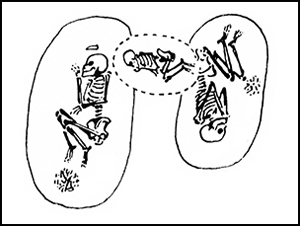Crossref Citations
This article has been cited by the following publications. This list is generated based on data provided by
Crossref.
Frieman, Catherine J.
2021.
Emergent or imposed?.
Antiquity,
Vol. 95,
Issue. 379,
p.
247.
Ensor, Bradley E.
2021.
Making aDNA useful for kinship analysis.
Antiquity,
Vol. 95,
Issue. 379,
p.
241.
Brück, Joanna
2021.
Kinship: politics and practice.
Antiquity,
Vol. 95,
Issue. 379,
p.
249.
Furholt, Martin
2021.
Exploring human possibilities.
Antiquity,
Vol. 95,
Issue. 379,
p.
244.
Soriano, I.
Herrero-Corral, A.M.
Garrido-Pena, R.
and
Majó, T.
2021.
Sex/gender system and social hierarchization in Bell Beaker burials from Iberia.
Journal of Anthropological Archaeology,
Vol. 64,
Issue. ,
p.
101335.
Crellin, Rachel J.
2021.
Making posthumanist kin in the past.
Antiquity,
Vol. 95,
Issue. 379,
p.
238.
Žegarac, A.
Winkelbach, L.
Blöcher, J.
Diekmann, Y.
Krečković Gavrilović, M.
Porčić, M.
Stojković, B.
Milašinović, L.
Schreiber, M.
Wegmann, D.
Veeramah, K. R.
Stefanović, S.
and
Burger, J.
2021.
Ancient genomes provide insights into family structure and the heredity of social status in the early Bronze Age of southeastern Europe.
Scientific Reports,
Vol. 11,
Issue. 1,
Bentley, R. Alexander
2022.
Prehistory of Kinship.
Annual Review of Anthropology,
Vol. 51,
Issue. 1,
p.
137.
Fowler, Chris
Olalde, Iñigo
Cummings, Vicki
Armit, Ian
Büster, Lindsey
Cuthbert, Sarah
Rohland, Nadin
Cheronet, Olivia
Pinhasi, Ron
and
Reich, David
2022.
A high-resolution picture of kinship practices in an Early Neolithic tomb.
Nature,
Vol. 601,
Issue. 7894,
p.
584.
Brück, Joanna
and
Booth, Thomas J.
2022.
The Power of Relics: The Curation of Human Bone in British Bronze Age Burials.
European Journal of Archaeology,
Vol. 25,
Issue. 4,
p.
440.
BLOXAM, ANNA
and
PARKER PEARSON, MIKE
2022.
Funerary Diversity and Cultural Continuity: The British Beaker Phenomenon Beyond the Stereotype.
Proceedings of the Prehistoric Society,
Vol. 88,
Issue. ,
p.
261.
Moore, Hazel
Wilson, Graeme
Ni Challanain, Mairead
McCormick, Maeve
Marshall, Peter D.
Dulias, Katharina
Foody, M. George B.
Justeau, Pierre
Pala, Maria
Richards, Martin B.
and
Edwards, Ceiridwen J.
2022.
Migration and community in Bronze Age Orkney: innovation and continuity at the Links of Noltland.
Antiquity,
Vol. 96,
Issue. 387,
p.
541.
Cintas-Peña, Marta
and
García Sanjuán, Leonardo
2022.
Women, residential patterns and early social complexity. From theory to practice in Copper Age Iberia.
Journal of Anthropological Archaeology,
Vol. 67,
Issue. ,
p.
101422.
Carlin, Neil
2022.
A grave matter of ancient kinship in Neolithic Britain.
Nature,
Vol. 601,
Issue. 7894,
p.
510.
Fowler, Chris
2022.
Social arrangements. Kinship, descent and affinity in the mortuary architecture of Early Neolithic Britain and Ireland.
Archaeological Dialogues,
Vol. 29,
Issue. 1,
p.
67.
Laing, Meredith
2022.
YOUNG HANDS AT WORK. USING FINGER IMPRESSIONS TO EXPLORE THE DEMOGRAPHIC CONSTITUTION OF EARLY AND MIDDLE BRONZE AGE POTTERY‐MAKING COMMUNITIES OF PRACTICE.
Oxford Journal of Archaeology,
Vol. 41,
Issue. 4,
p.
350.
Knight, Matthew G.
2023.
Nostalgia in the prehistoric archaeological record.
Current Opinion in Psychology,
Vol. 50,
Issue. ,
p.
101560.
Harney, Éadaoin
Micheletti, Steven
Bruwelheide, Karin S.
Freyman, William A.
Bryc, Katarzyna
Akbari, Ali
Jewett, Ethan
Comer, Elizabeth
Gates, Henry Louis
Heywood, Linda
Thornton, John
Curry, Roslyn
Esselmann, Samantha Ancona
Barca, Kathryn G.
Sedig, Jakob
Sirak, Kendra
Olalde, Iñigo
Adamski, Nicole
Bernardos, Rebecca
Broomandkhoshbacht, Nasreen
Ferry, Matthew
Qiu, Lijun
Stewardson, Kristin
Workman, J. Noah
Zalzala, Fatma
Mallick, Shop
Micco, Adam
Mah, Matthew
Zhang, Zhao
Rohland, Nadin
Mountain, Joanna L.
Owsley, Douglas W.
Reich, David
Aslibekyan, Stella
Auton, Adam
Babalola, Elizabeth
Bell, Robert K.
Bielenberg, Jessica
Bullis, Emily
Coker, Daniella
Cuellar Partida, Gabriel
Dhamija, Devika
Das, Sayantan
Elson, Sarah L.
Filshtein, Teresa
Fletez-Brant, Kipper
Fontanillas, Pierre
Heilbron, Karl
Hicks, Barry
Hinds, David A.
Jiang, Yunxuan
Kukar, Katelyn
Lin, Keng-Han
Lowe, Maya
McCreight, Jey
McIntyre, Matthew H.
Moreno, Meghan E.
Nandakumar, Priyanka
Noblin, Elizabeth S.
O’Connell, Jared
Petrakovitz, Aaron A.
Poznik, G. David
Schumacher, Morgan
Shastri, Anjali J.
Shelton, Janie F.
Shi, Jingchunzi
Shringarpure, Suyash
Tran, Vinh
Tung, Joyce Y.
Wang, Xin
Wang, Wei
Weldon, Catherine H.
Wilton, Peter
Hernandez, Alejandro
Wong, Corinna D.
Tchakouté, Christophe Toukam
Fitch, Alison
Reynoso, Alexandra
Granka, Julie M.
Su, Qiaojuan Jane
Kwong, Alan
Eriksson, Nicholas
Nguyen, Dominique T.
Llamas, Bianca A.
and
Tat, Susana A.
2023.
The genetic legacy of African Americans from Catoctin Furnace.
Science,
Vol. 381,
Issue. 6657,
Vyas, Deven N.
Koncz, István
Modi, Alessandra
Mende, Balázs Gusztáv
Tian, Yijie
Francalacci, Paolo
Lari, Martina
Vai, Stefania
Straub, Péter
Gallina, Zsolt
Szeniczey, Tamás
Hajdu, Tamás
Pejrani Baricco, Luisella
Giostra, Caterina
Radzevičiūtė, Rita
Hofmanová, Zuzana
Évinger, Sándor
Bernert, Zsolt
Pohl, Walter
Caramelli, David
Vida, Tivadar
Geary, Patrick J.
and
Veeramah, Krishna R.
2023.
Fine-scale sampling uncovers the complexity of migrations in 5th–6th century Pannonia.
Current Biology,
Vol. 33,
Issue. 18,
p.
3951.
Skourtanioti, Eirini
Ringbauer, Harald
Gnecchi Ruscone, Guido Alberto
Bianco, Raffaela Angelina
Burri, Marta
Freund, Cäcilia
Furtwängler, Anja
Gomes Martins, Nuno Filipe
Knolle, Florian
Neumann, Gunnar U.
Tiliakou, Anthi
Agelarakis, Anagnostis
Andreadaki-Vlazaki, Maria
Betancourt, Philip
Hallager, Birgitta P.
Jones, Olivia A.
Kakavogianni, Olga
Kanta, Athanasia
Karkanas, Panagiotis
Kataki, Efthymia
Kissas, Konstantinos
Koehl, Robert
Kvapil, Lynne
Maran, Joseph
McGeorge, Photini J. P.
Papadimitriou, Alkestis
Papathanasiou, Anastasia
Papazoglou-Manioudaki, Lena
Paschalidis, Kostas
Polychronakou-Sgouritsa, Naya
Preve, Sofia
Prevedorou, Eleni-Anna
Price, Gypsy
Protopapadaki, Eftychia
Schmidt-Schultz, Tyede
Schultz, Michael
Shelton, Kim
Wiener, Malcolm H.
Krause, Johannes
Jeong, Choongwon
and
Stockhammer, Philipp W.
2023.
Ancient DNA reveals admixture history and endogamy in the prehistoric Aegean.
Nature Ecology & Evolution,





